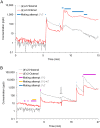Real-time measurement of volatile chemicals released by bed bugs during mating activities
- PMID: 23227225
- PMCID: PMC3515544
- DOI: 10.1371/journal.pone.0050981
Real-time measurement of volatile chemicals released by bed bugs during mating activities
Abstract
In recent years, bed bug (Hemiptera: Cimicidae) problems have increased dramatically in many parts of the world, leading to a renewed interest in their chemical ecology. Most studies of bed bug semiochemicals have been based on the collection of volatiles over a period of time followed by chemical analysis. Here we present for the first time, a combination of proton transfer reaction mass spectrometry and video analysis for real-time measurement of semiochemicals emitted by isolated groups of bed bugs during specific behavioural activities. The most distinct peaks in the proton transfer reaction mass spectrometry recordings were always observed close to the termination of mating attempts, corresponding to the defensive emissions that bed bugs have been suspected to exploit for prevention of unwanted copulations. The main components of these emissions were (E)-2-hexenal and (E)-2-octenal recorded in ratios between 1:3 and 3:1. In the current study, the quantity varied over 1000 fold for both of the compounds with up to 40 µg total release in a single emission. Males also emit defensive compounds due to homosexual copulation attempts by other males, and no significant differences were observed in the ratio or the amount of the two components released from males or females. In summary, this study has demonstrated that combining proton-transfer-reaction mass spectrometry with video analysis can provide detailed information about semiochemicals emitted during specific behavioural activities.
Conflict of interest statement
Figures




Similar articles
-
A bioassay for studying behavioural responses of the common bed bug, Cimex lectularius (Hemiptera: Cimicidae) to bed bug-derived volatiles.Bull Entomol Res. 2011 Feb;101(1):1-8. doi: 10.1017/S0007485309990599. Epub 2010 Jan 27. Bull Entomol Res. 2011. PMID: 20102661
-
Bed bug aggregation pheromone finally identified.Angew Chem Int Ed Engl. 2015 Jan 19;54(4):1135-8. doi: 10.1002/anie.201409890. Epub 2014 Dec 21. Angew Chem Int Ed Engl. 2015. PMID: 25529634
-
Nymphs of the common bed bug (Cimex lectularius) produce anti-aphrodisiac defence against conspecific males.BMC Biol. 2010 Sep 9;8:121. doi: 10.1186/1741-7007-8-121. BMC Biol. 2010. PMID: 20828381 Free PMC article.
-
Semiochemicals of the common bed bug, Cimex lectularius L. (Hemiptera: Cimicidae), and their potential for use in monitoring and control.Pest Manag Sci. 2011 Jan;67(1):10-20. doi: 10.1002/ps.2024. Epub 2010 Sep 21. Pest Manag Sci. 2011. PMID: 20859928 Review.
-
Semiochemicals modulating bed bug behaviour.Curr Opin Insect Sci. 2024 Aug;64:101207. doi: 10.1016/j.cois.2024.101207. Epub 2024 May 29. Curr Opin Insect Sci. 2024. PMID: 38821142 Review.
Cited by
-
Recalibrating Olfactory Neuroscience to the Range of Naturally Occurring Odor Concentrations.J Neurosci. 2025 Mar 5;45(10):e1872242024. doi: 10.1523/JNEUROSCI.1872-24.2024. J Neurosci. 2025. PMID: 40044450 Review.
-
Chemically Mediated Arrestment of the Bed Bug, Cimex lectularius, by Volatiles Associated with Exuviae of Conspecifics.PLoS One. 2016 Jul 19;11(7):e0159520. doi: 10.1371/journal.pone.0159520. eCollection 2016. PLoS One. 2016. PMID: 27434044 Free PMC article.
-
Odor characterization of the poultry red mite (Dermanyssus gallinae) for identification of volatile biomarkers of infestation across multiple commercial laying hen systems.Poult Sci. 2025 Jun;104(6):105101. doi: 10.1016/j.psj.2025.105101. Epub 2025 Mar 25. Poult Sci. 2025. PMID: 40158286 Free PMC article.
-
Volatile Organic Compounds: A Promising Tool for Bed Bug Detection.Int J Environ Res Public Health. 2023 Mar 22;20(6):5214. doi: 10.3390/ijerph20065214. Int J Environ Res Public Health. 2023. PMID: 36982123 Free PMC article. Review.
-
Ontogenesis of Aldehyde Pheromones in Two Synanthropic Bed Bug Species (Heteroptera: Cimicidae).Insects. 2020 Nov 5;11(11):759. doi: 10.3390/insects11110759. Insects. 2020. PMID: 33167323 Free PMC article.
References
-
- Panagiotakopulu E, Buckland PC (1999) Cimex lectularius L., the common bed bug from Pharaonic Egypt. Antiquity 73: 908–911.
-
- Usinger RL (1966) Monograph of Cimicidae. The Thomas Say Foundation. Entomological Society of America, College Park. 583 pp.
-
- Weeks ENI, Birkett MA, Cameron M, Pickett JA, Logan JG (2010) Semiochemicals of the common bed bug, Cimex lectularius L. (Hemiptera: Cimicidae), and their potential for use in monitoring and control. Pest Management Science 67: 10–20. - PubMed
-
- Collins RP (1968) Carbonyl compounds produced by the bed bug, Cimex lectularius . Annals of the Entomological Society of America 61: 1338–1340.
-
- Levinson H Z, Levinson A R, Maschwitz U (1974) Action and composition of the alarm pheromone of the bedbug Cimex lectularius L. Naturwissenschaften. 61: 684–685. - PubMed
Publication types
MeSH terms
Substances
LinkOut - more resources
Full Text Sources
Medical

